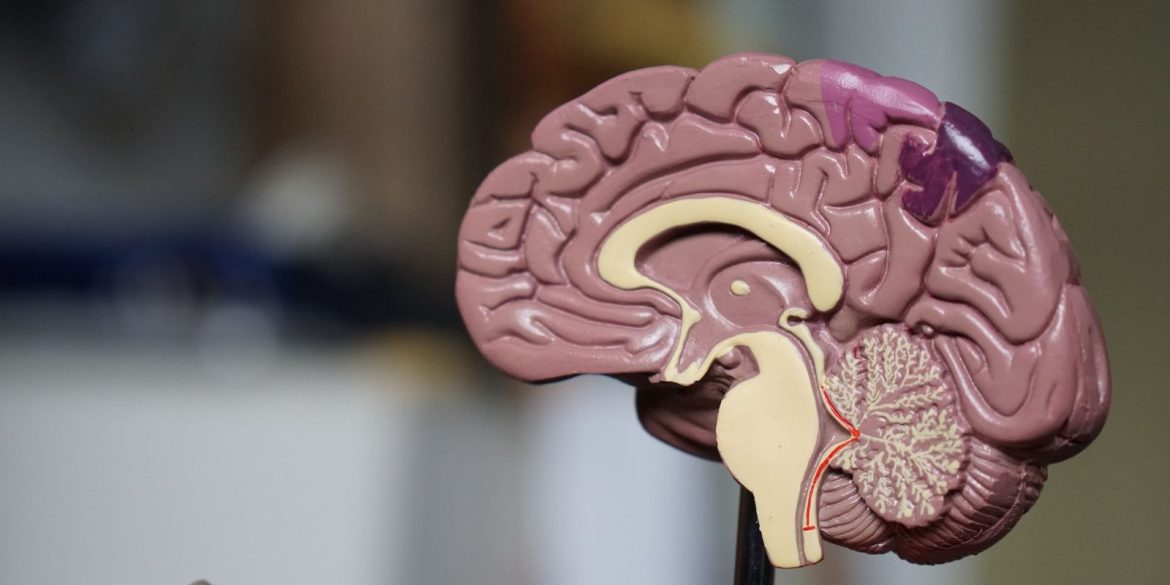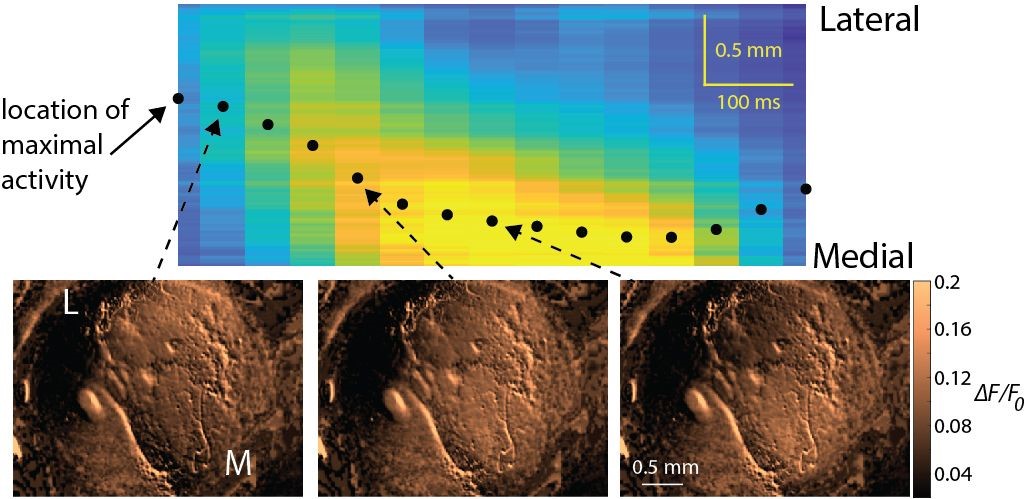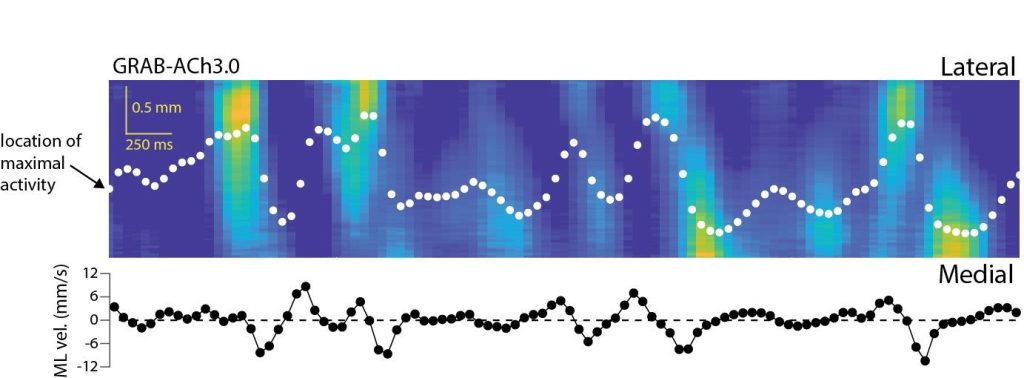
In a new study, a group of researchers, led by Dr Joshua Goldberg from the Hebrew University, describe a new kind of neurochemical wave in the brain. Their research, published in Nature Communications, unveils the existence of traveling waves of the neurochemical acetylcholine in the striatum, a region of the brain responsible for motivating actions and habitual behaviours.
The motivation to execute an action is widely thought to depend on the release of the another neurochemical, dopamine, in the striatum. Recent research has shown that dopamine is released in wave-like patterns within the striatum. The team led by Goldberg discovered that acetylcholine is also released in the striatum in wave-like patterns. It has long been thought that in order for the striatum to function properly a balance needs to be maintained between dopamine and acetylcholine release in the striatum, and that the disruption of this balance leads to movement disorders such as Parkinson’s disease. The new study proposes a mathematical mechanism by which simultaneous waves of acetylcholine and dopamine arise, which may represent how this balance is realised.
The research was conducted using state-of-the-art genetic tools and advanced imaging techniques, allowing the team to visualise the acetylcholine waves in awake, behaving animals. Additionally, imaging techniques were employed to observe the interaction between acetylcholine and dopamine in vitro. Through a rigorous mathematical analysis, using reaction-diffusion activator-inhibitor models and computer simulations, the team proposed a model that explains the formation of both acetylcholine (the activator) and dopamine (the inhibitor) traveling waves.
Key Highlights of the Study:
First description of acetylcholine waves: in the striatum of healthy behaving animals.
Local Dopamine Release is Triggered by individual non-dopamine neurons: The study demonstrated that electrical activation of a single acetylcholine-releasing neuron in the striatum is sufficient to induce local dopamine release in its proximity.
A novel model for how the two neurochemical waves arise simultaneously: The study proposes a novel mathematical model based on the known interaction between acetylcholine and dopamine in the striatum, that can give rise to the simultaneous generation of these waves.
Finally, the study provides strong testable predictions about the relationship between these two wave phenomena and the neural mechanism for their formation. The study also proposes that dopamine and acetylcholine axons (which are the very long appendages of the dopamine and acetylcholine neurons) interact directly and locally in the striatum, which is not how neurons are traditionally thought to interact.
The research paper titled “Acetylcholine waves and dopamine release in the striatum” is now available in Nature Communications for further details https://www.nature.com/articles/s41467-023-42311-5?utm_source=rct_congratemailt&utm_medium=email&utm_campaign=oa_20231027&utm_content=10.1038/s41467-023-42311-5
Research Team: Lior Matityahu1, Naomi Gilin1, Gideon A. Sarpong2, Yara Atamna1, Lior Tiroshi1, Nicolas X. Tritsch3, Jeffery R. Wickens2 & Joshua A. Goldberg1
Institutions:
1. Department of Medical Neurobiology, Institute of Medical Research Israel – Canada, The Faculty of Medicine, The Hebrew University of Jerusalem, Israel.
2. Okinawa Institute of Science and Technology Graduate University, Japan.
3. Neuroscience Institute, New York University, USA.
Collaboration with leading experts played a crucial role in this research, with Prof Jeffery Wickens, Dr Gideon Sarpong, and Dr Nicolas Tristch contributing invaluable imaging data, showcasing the traveling waves of acetylcholine in freely moving animals.
Funding:
This work was funded by a Research Grant from the Human Frontier Science Program (HFSP) no. RGP0062/2019 to J.R.W. and J.A.G.; by an European Research Council (ERC) Consolidator Grant (no. 646886) to J.A.G.; and by grants from the National Institutes of Health (DP2NS105553 and R01MH130658) and Dana and Whitehall Foundations to N.X.T. We thank Loren Looger for providing iAChSnFR and Kiyoto Kurima for cloning iAChSnFR into a partially modified AAV-Tetoff-vector.
Pictures:
Acetylcholine wave traveling from lateral (L) to medial (M) in the striatum
Credit: Dr. Joshua Goldberg, Prof. Jeffery Wickens, Dr. Nicolas Tristch

Top: a space (y-axis) – time (x-axis) rendition of the location of the acetylcholine release shows it moving in the mediolateral (ML) direction. Bottom: The velocity changes sign when the direction of the acetylcholine wave is reversed
Credit: Dr Joshua Goldberg, Prof Jeffery Wickens, Dr Nicolas Tristch

Disclaimer: In these challenging times of war and crisis, Hebrew University of Jerusalem is resolute in its dedication to advancing research and education. We stand in full support of the brave individuals on the frontlines, safeguarding our nation and the well-being of all Israelis, and extend our deepest gratitude and unwavering solidarity to our community and fellow citizens. Together, we shall prevail against the challenges that confront us, and our shared commitment to the well-being of all Israelis and the pursuit of knowledge remains resolute.
The Hebrew University of Jerusalem is Israel’s premier academic and research institution. With over 25,000 students from 90 countries, it is a hub for advancing scientific knowledge and holds a significant role in Israel’s civilian scientific research output, accounting for nearly 40% of it and has registered over 11,000 patents. The university’s faculty and alumni have earned eight Nobel Prizes and a Fields Medal, underscoring their contributions to ground-breaking discoveries. In the global arena, the Hebrew University ranks 86th according to the Shanghai Ranking. To learn more about the university’s academic programs, research initiatives, and achievements, visit the official website at http://new.huji.ac.il/en
